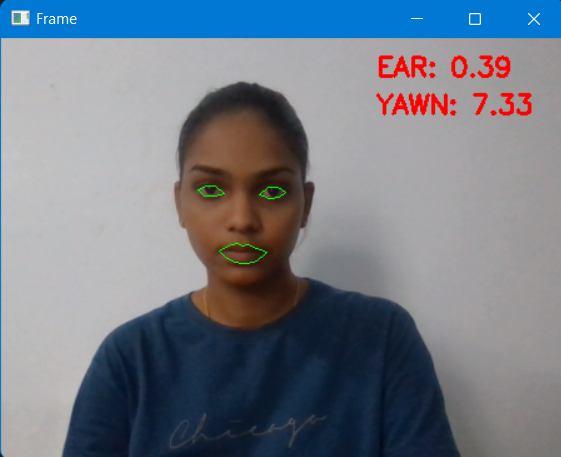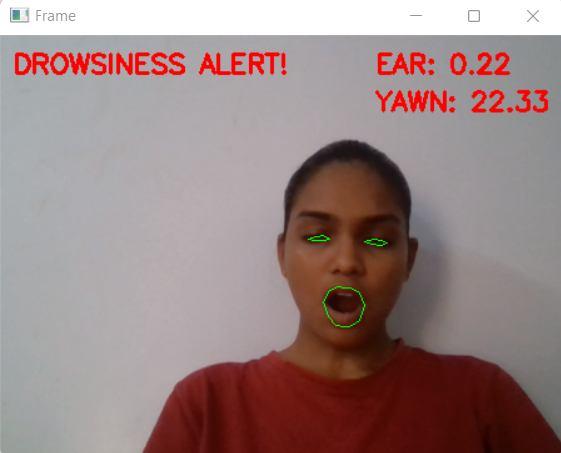
2 minute read
International Journal for Research in Applied Science & Engineering Technology (IJRASET)
ISSN: 2321-9653; IC Value: 45.98; SJ Impact Factor: 7.538
Volume 11 Issue IV Apr 2023- Available at www.ijraset.com
Advertisement
In the above output drowsiness is detected because the person has Yawned, and the MAR value falls below the mouth threshold value. Because of which the system has classified that the person is feeling drowsy.
In the above output drowsiness is detected because the person has Yawned, and closed the eyes for too long, so the EAR and MAR values falls below the threshold values. Because of which the system has classified that the person is feeling drowsy.



2) Frames Classified as Active (not drowsy)
Here the input will be the continuous stream of video, if the driver seems to be detected as active then EAR and MAR values will be continuously tracked.
ISSN: 2321-9653; IC Value: 45.98; SJ Impact Factor: 7.538

Volume 11 Issue IV Apr 2023- Available at www.ijraset.com
In the above output drowsiness is not detected because the persons EAR and MAR values are in the limits of the respected threshold values, because of which the system has classified that the person is Active.
V. CONCLUSION
A driver drowsiness detection system using OpenCV and CNN is a promising technology that has the potential to improve road safety by alerting drivers when they are getting drowsy or distracted. The system works by analyzing the driver's face and eyes to detect signs of drowsiness, such as drooping eyelids and yawning. The drowsiness detection system can be implemented in every vehicle such that we can prevent road accidents and decrease the death ratio which are caused due to drowsiness. As AI techniques are growing vastly, we can make systems more intelligent to understand the requirements of the hour. We can introduce various models and use different types of algorithms to get the best results. Based on the result analysis of the proposed system, it is concluded that it is effective in detecting drowsiness accurately. The proposed methodology has achieved 99% accuracy. Overall, a driver drowsiness detection system using OpenCV and CNN has the potential to be an effective tool for enhancing road safety and reducing the risk of accidents caused by driver drowsiness.
VI. ACKNOWLEDGMENT
We want to express our deep-felt gratitude and sincere thanks to our guide Mrs. Shilpa Shesham, Assistant Professor, Department of AI, Anurag University, for her skilful guidance, timely suggestions, and encouragement in completing this project. We want to express our profound gratitude to all for having helped us in achieving this dissertation. Finally, we would like to express our heartfelt thanks to our parents, who were very financially and mentally supportive and for their encouragement to achieve our goals.
References
[1] Altameem, A. Kumar, R. C. Poonia, S. Kumar and A. K. J. Saudagar, “Early Identification and Detection of Driver Drowsiness by Hybrid Machine Learning”, IEEE Access, Vol. No. 9, 2021.
[2] B. K. Savaş and Y. Becerikli, “Real Time Driver Fatigue Detection System Based on Multi-Task ConNN”, IEEE Access, Vol. No. 8, 2020.
[3] A. Rajkar, N. Kulkarni and A. Raut, ”Driver Drowsiness Detection Using Deep Learning”, ICCET Advances in Intelligent Systems and Computing, Springer, Vol. No. 1354, 2021.
[4] M. J. Flores, J. M. Armingol and A. de la Escalera,“Real-Time Warning System for Driver Drowsiness Detection Using Visual A Information”, Journal of Intelligent and Robotic Systems, Springer, 2019.


